Abstract
Three experiments using multiple schedules of reinforcement explored the implications of resistance-to-change findings for the response-reinforcer relation described by the law of effect, using both steady-state responding and responding recorded in the first few sessions of conditions. In Experiment 1, when response-independent reinforcement was increased during a third component, response rate in Components 1 and 2 decreased. This response-rate reduction was proportionately greater in a component in which reinforcer magnitude was small (2-s access to wheat) than in the component in which it was large (6-s access to wheat). However, when reinforcer rates in the two components were varied together in Experiments 2 and 3, response-rate change was the same regardless of the magnitude of reinforcers used in the two components, so that sensitivity of response rates to reinforcer rates (Experiment 2) and of response-rate ratios to reinforcer-rate ratios (Experiment 3) was unaffected by the magnitude of the reinforcers. Therefore, the principles determining resistance to change, described by behavioral momentum theory, seem not to apply when the source of behavior change is the variation of reinforcement contingencies that maintain the behavior. The use of extinction as a manipulation to study resistance to change is questioned.
Keywords: resistance to change, quantitative law of effect, generalized matching law, sensitivity to reinforcement, behavioral momentum, multiple schedules, key peck, pigeons
Full text
PDF

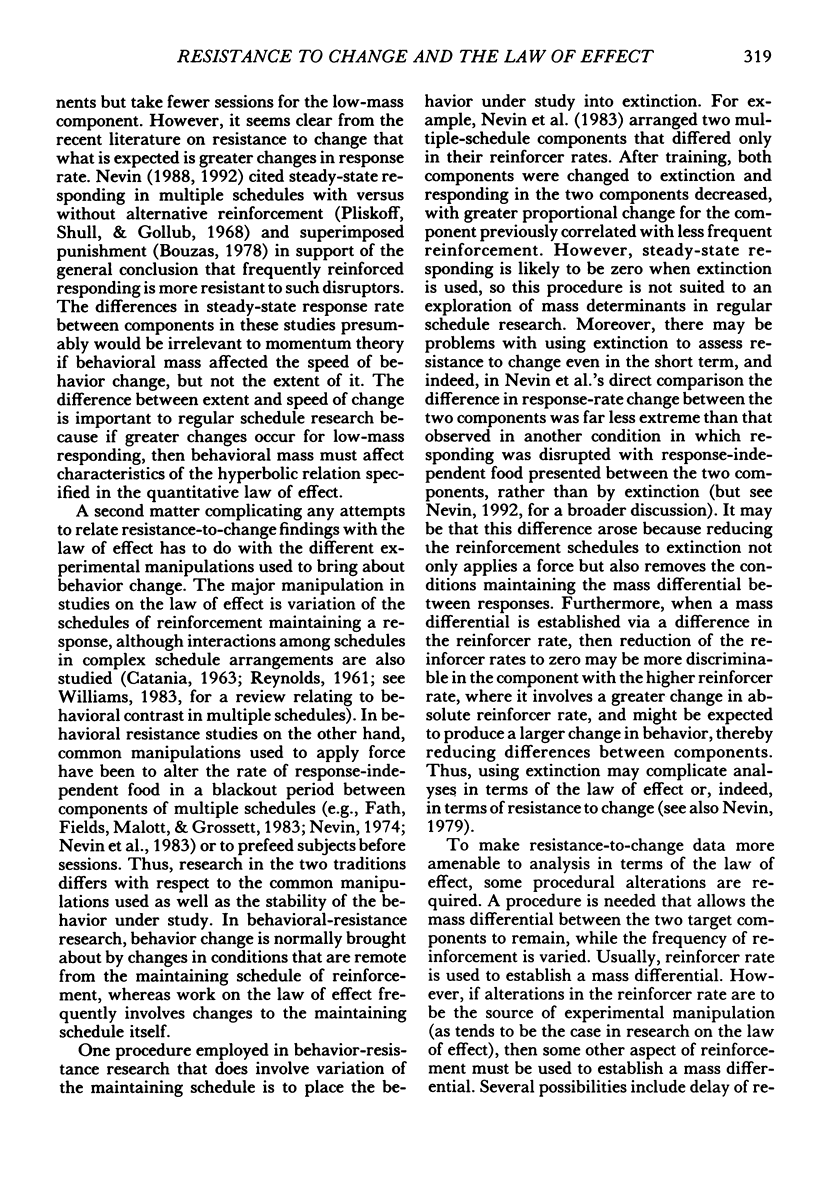
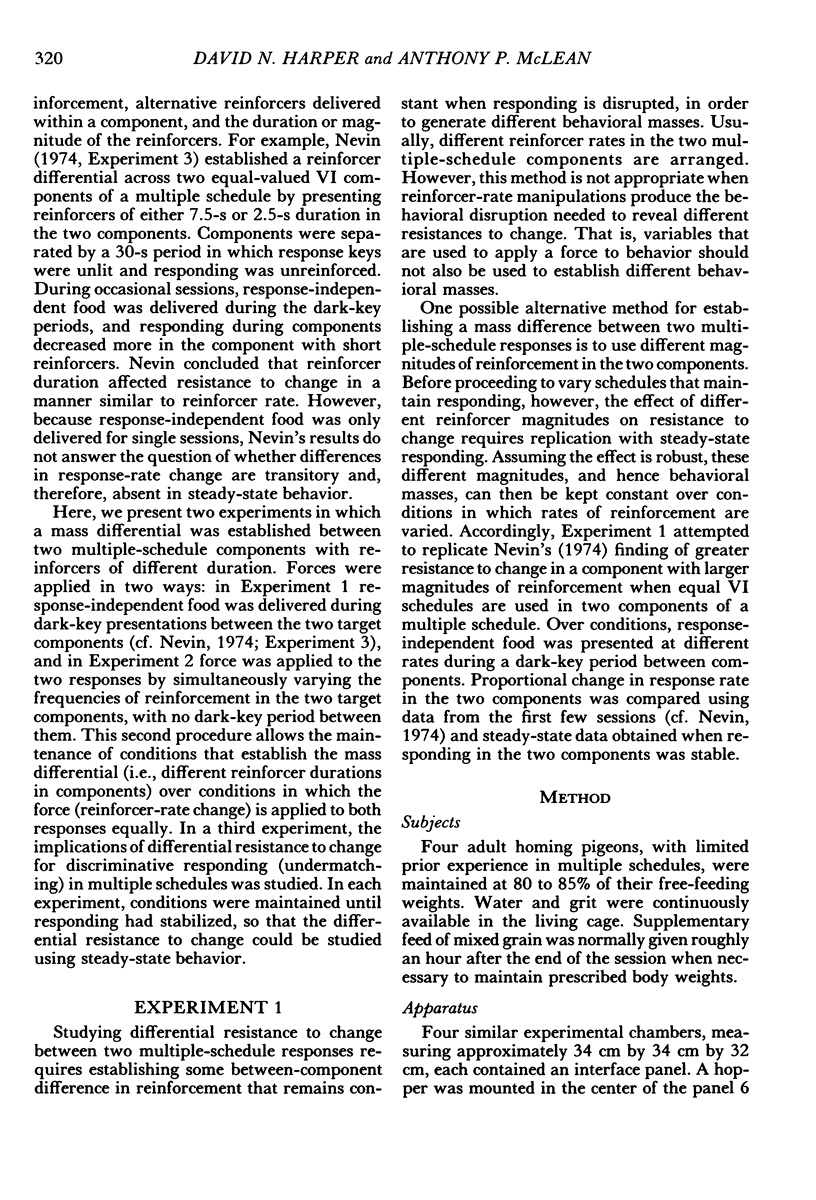
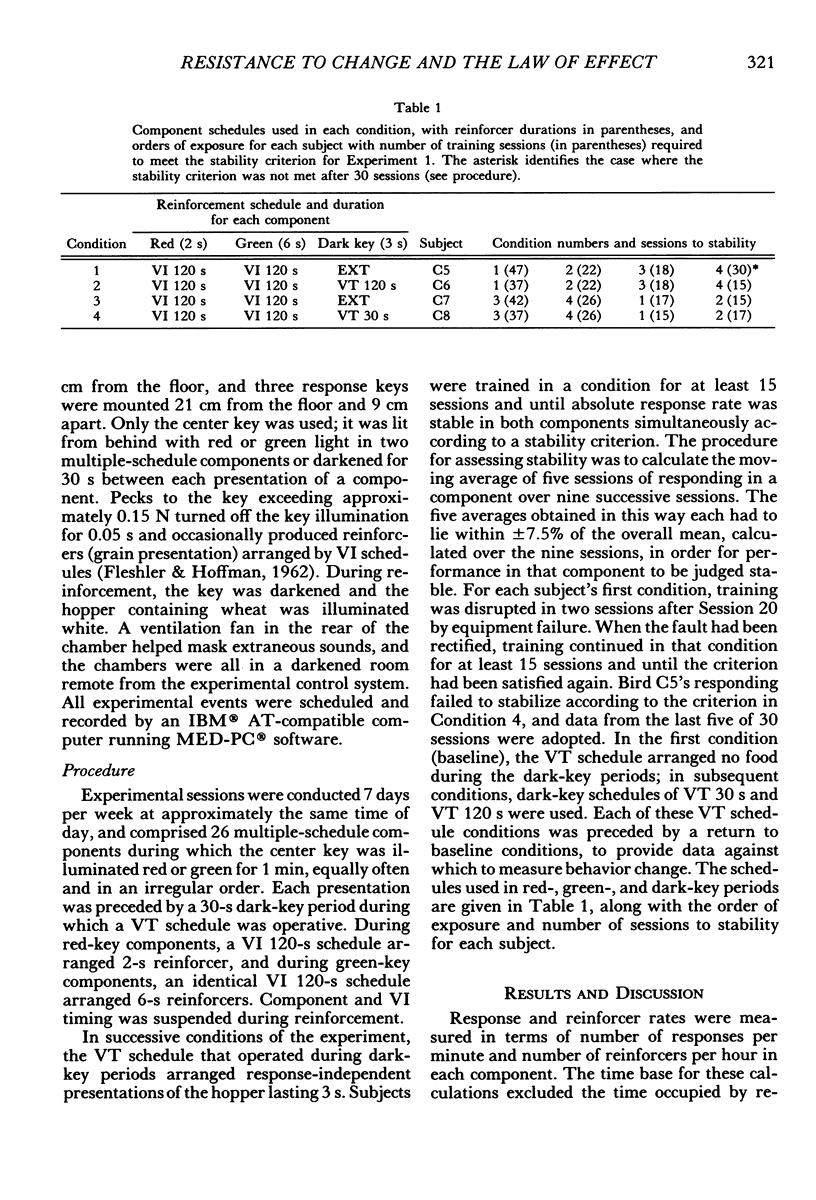
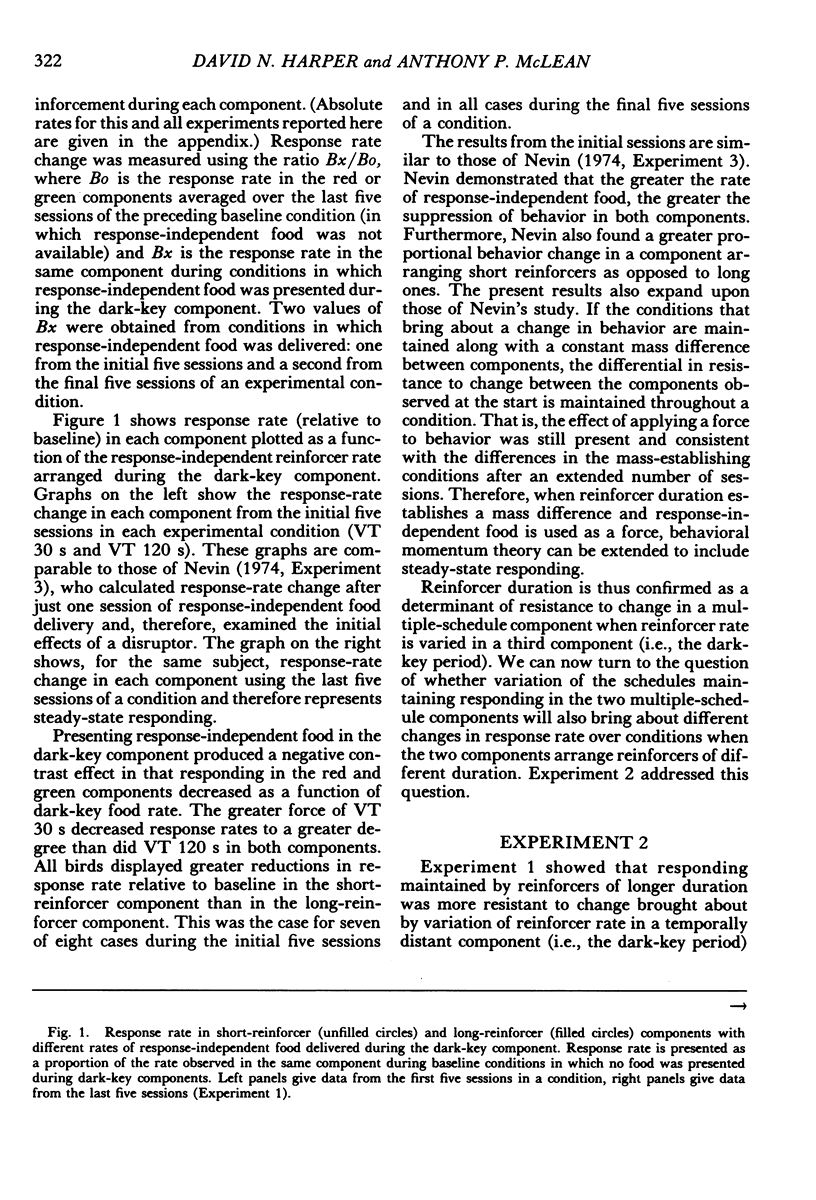
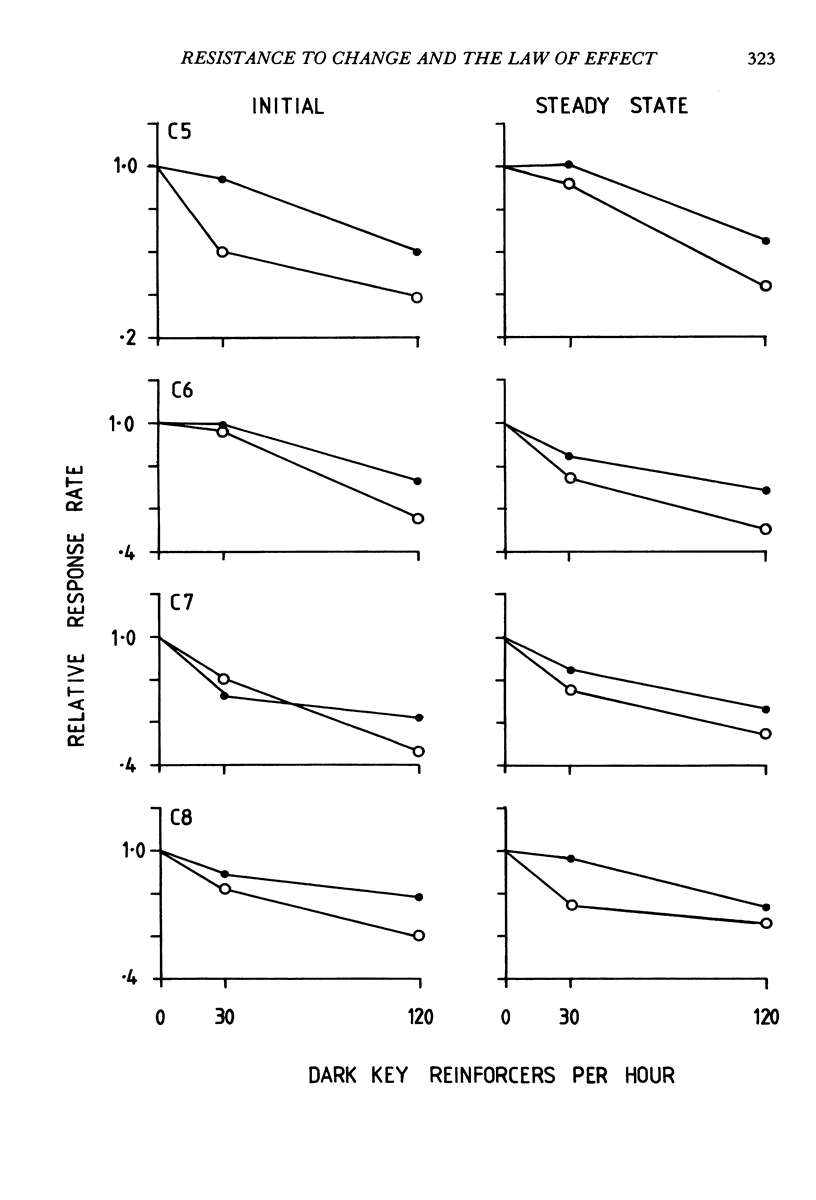
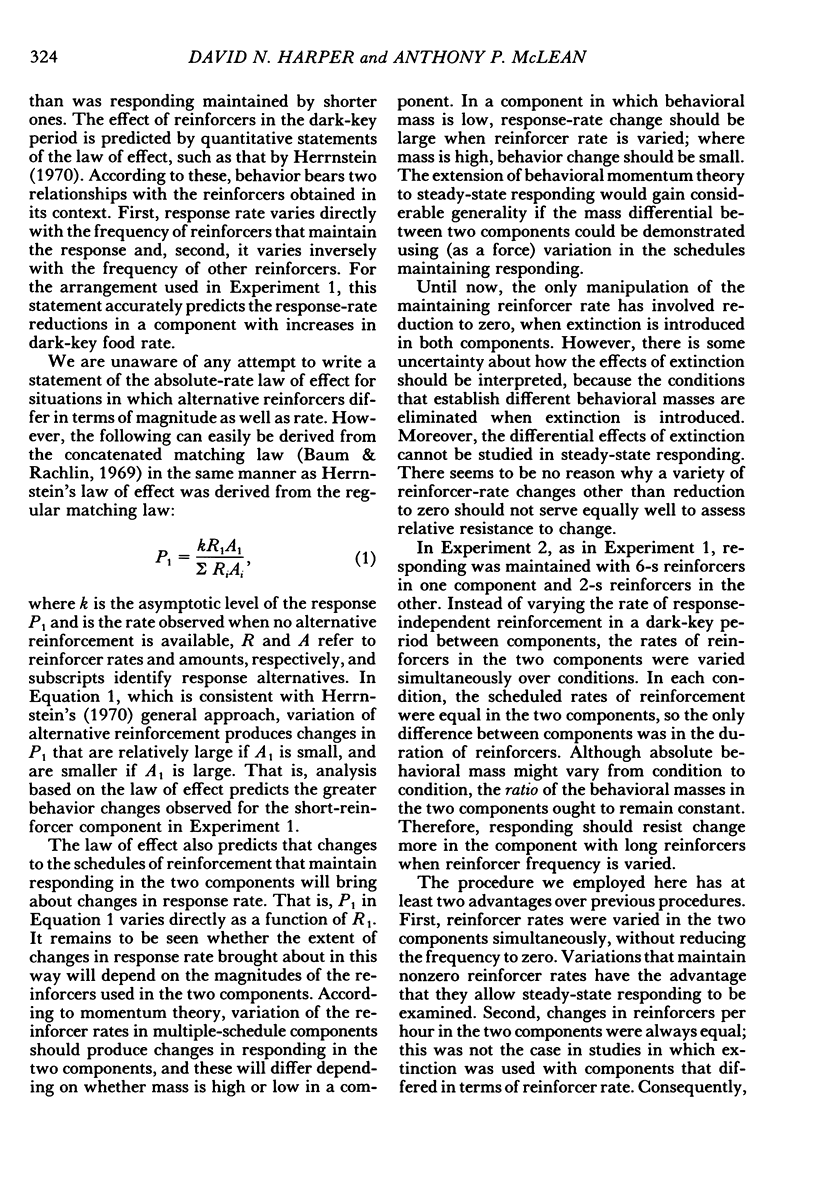
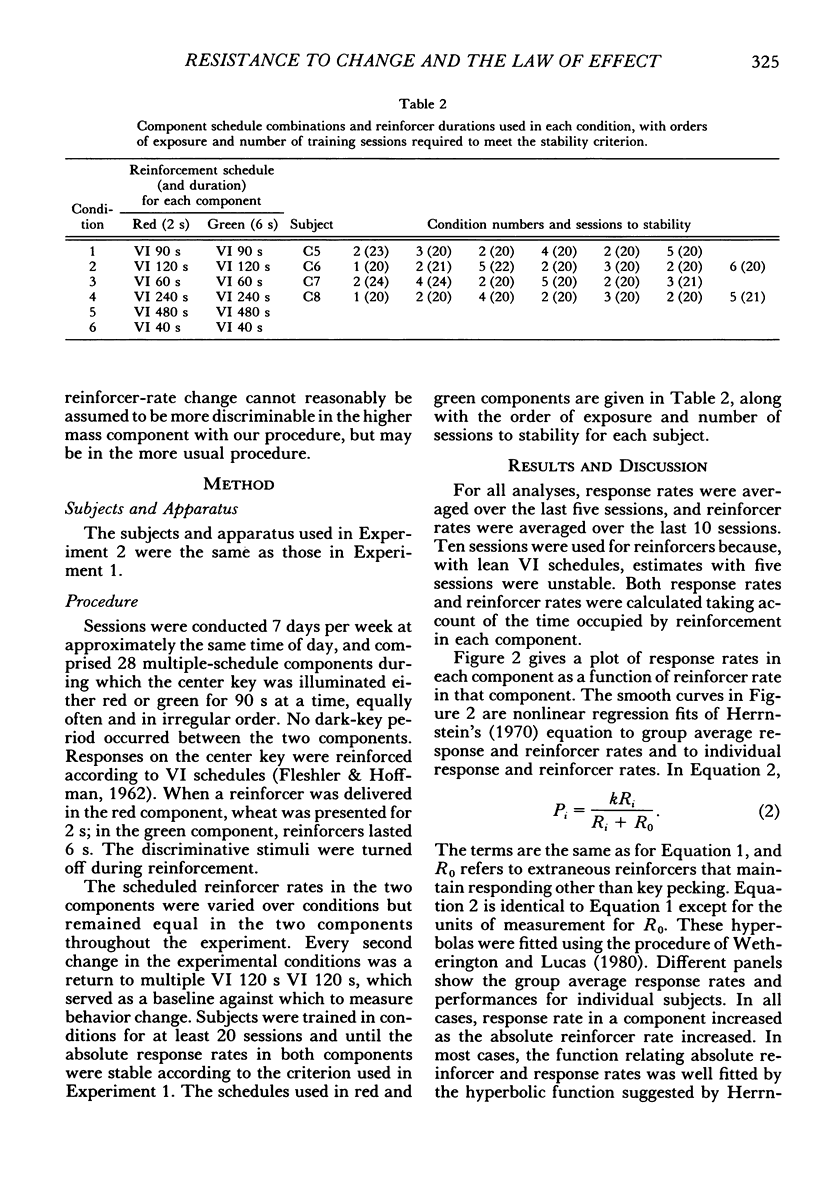
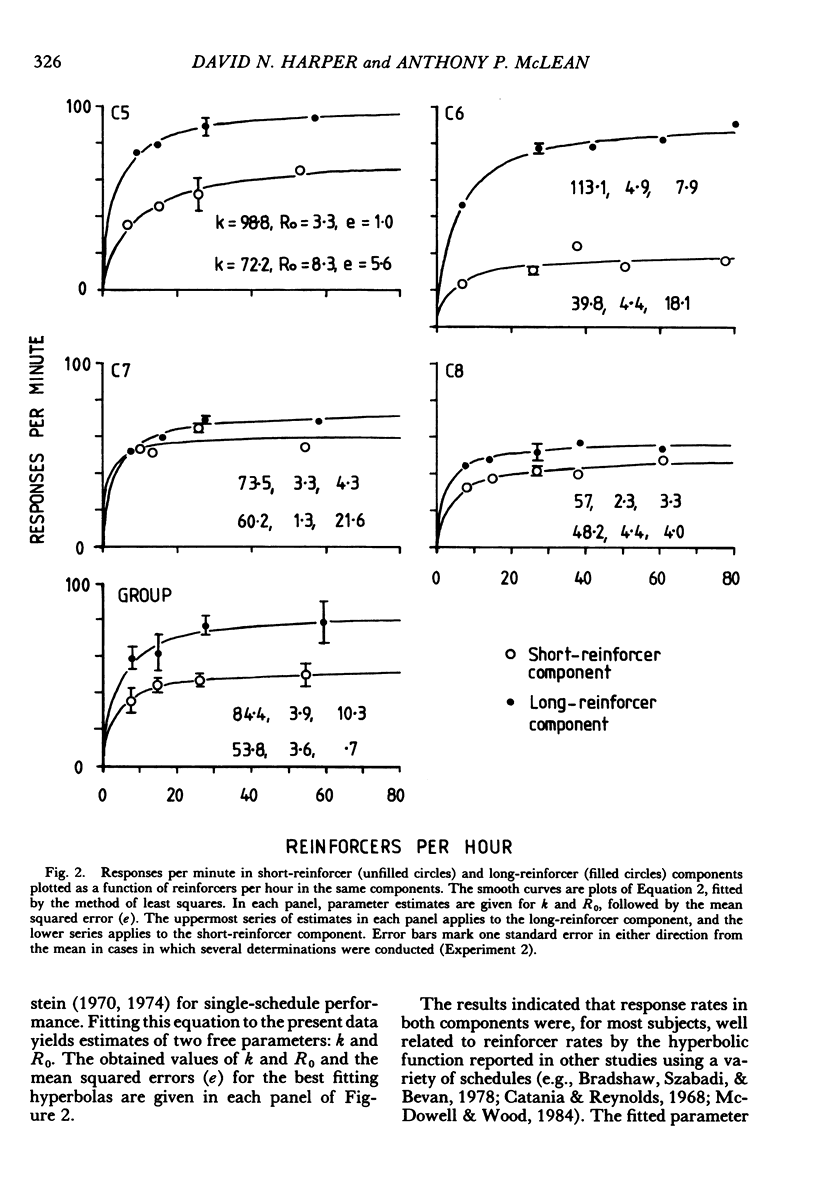
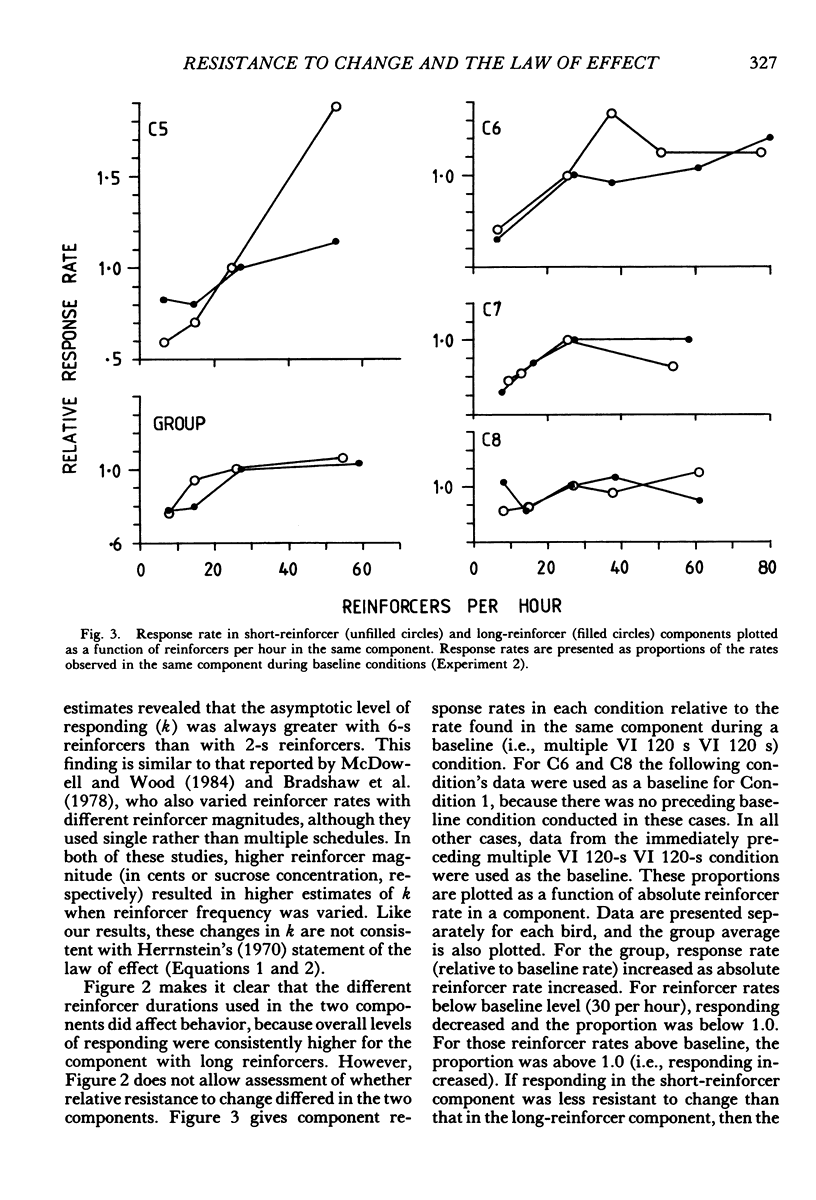
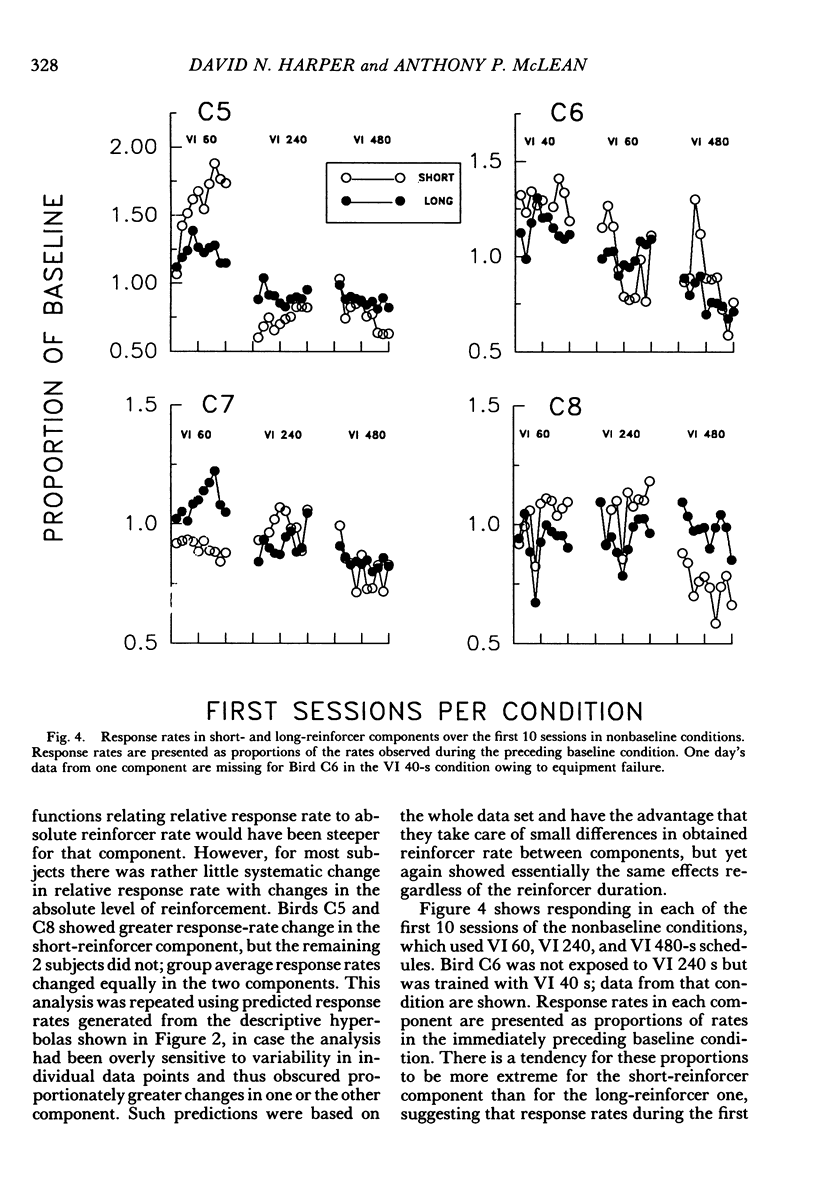
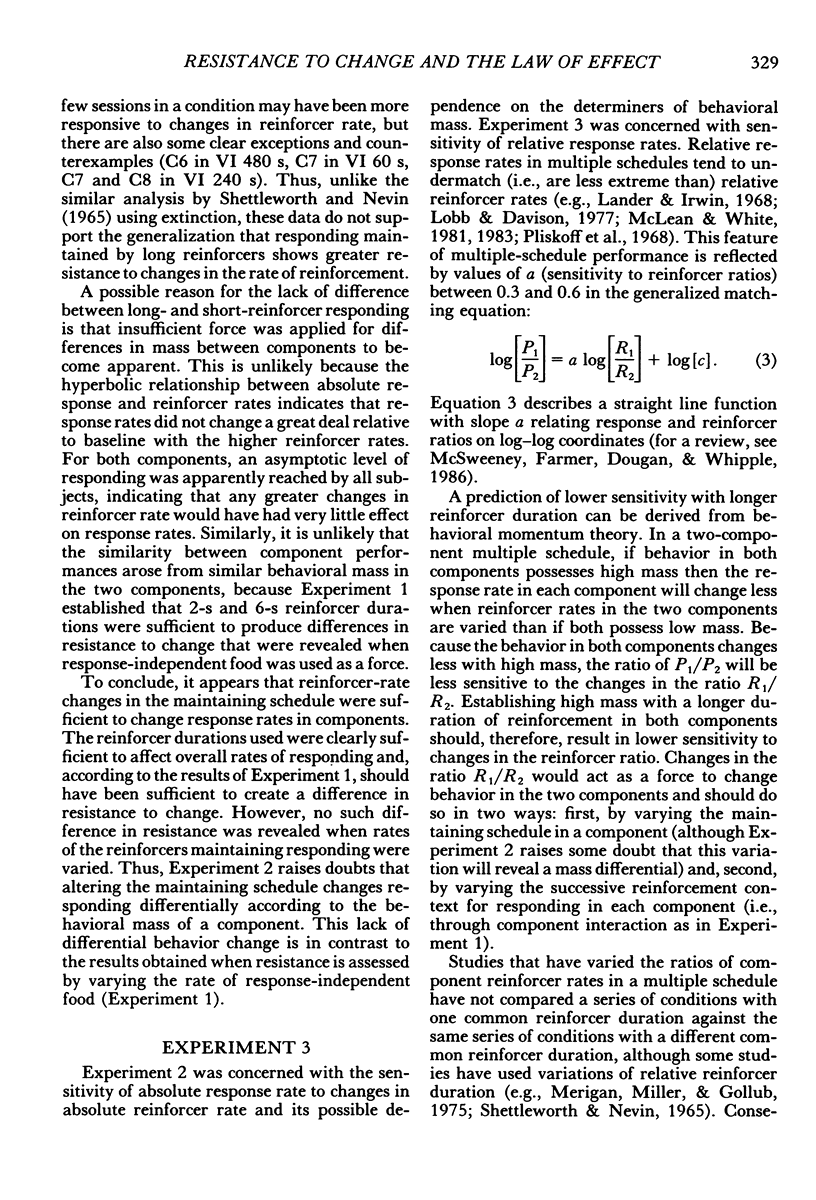

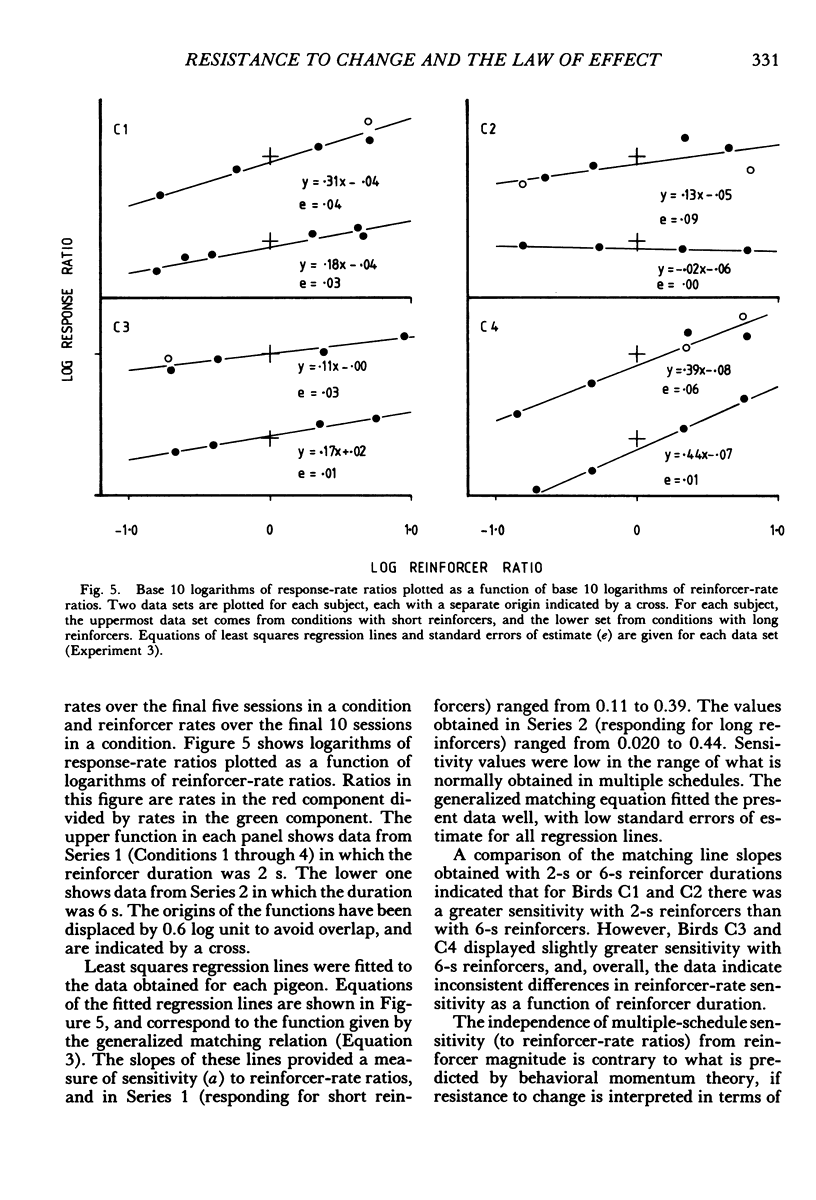

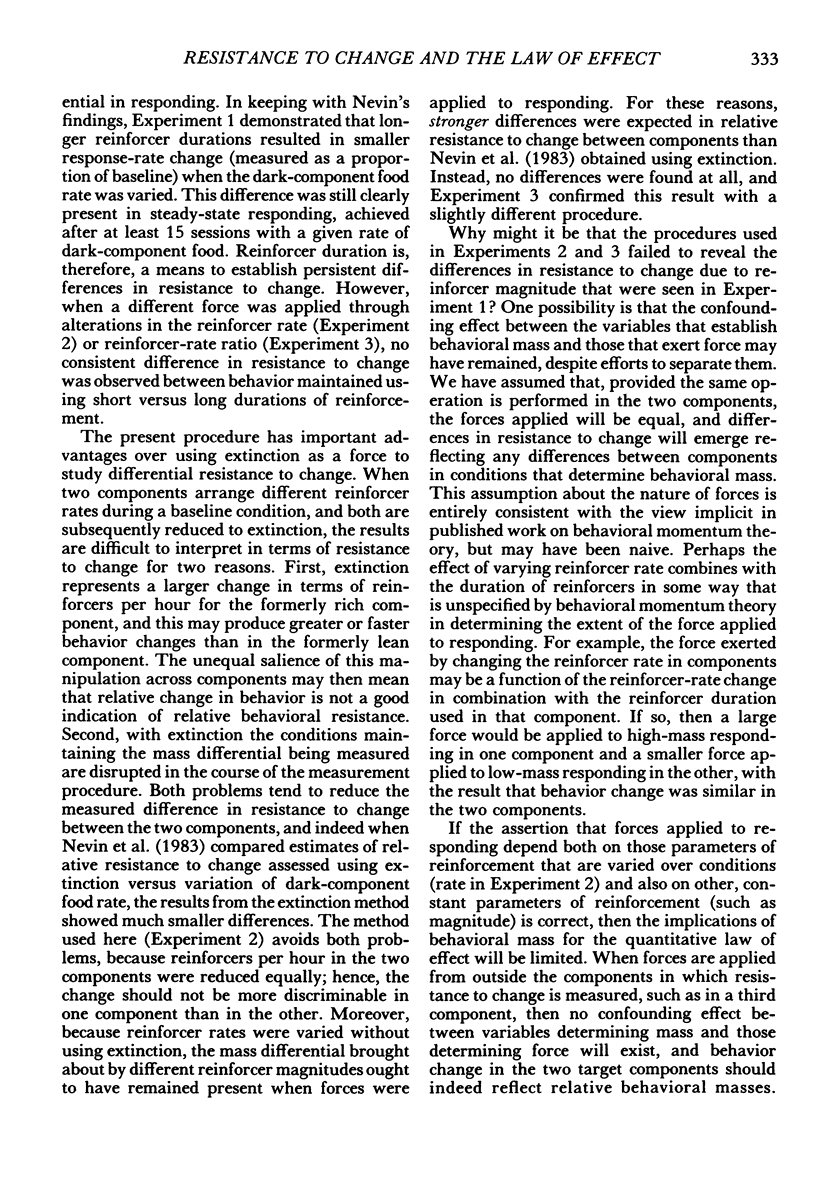


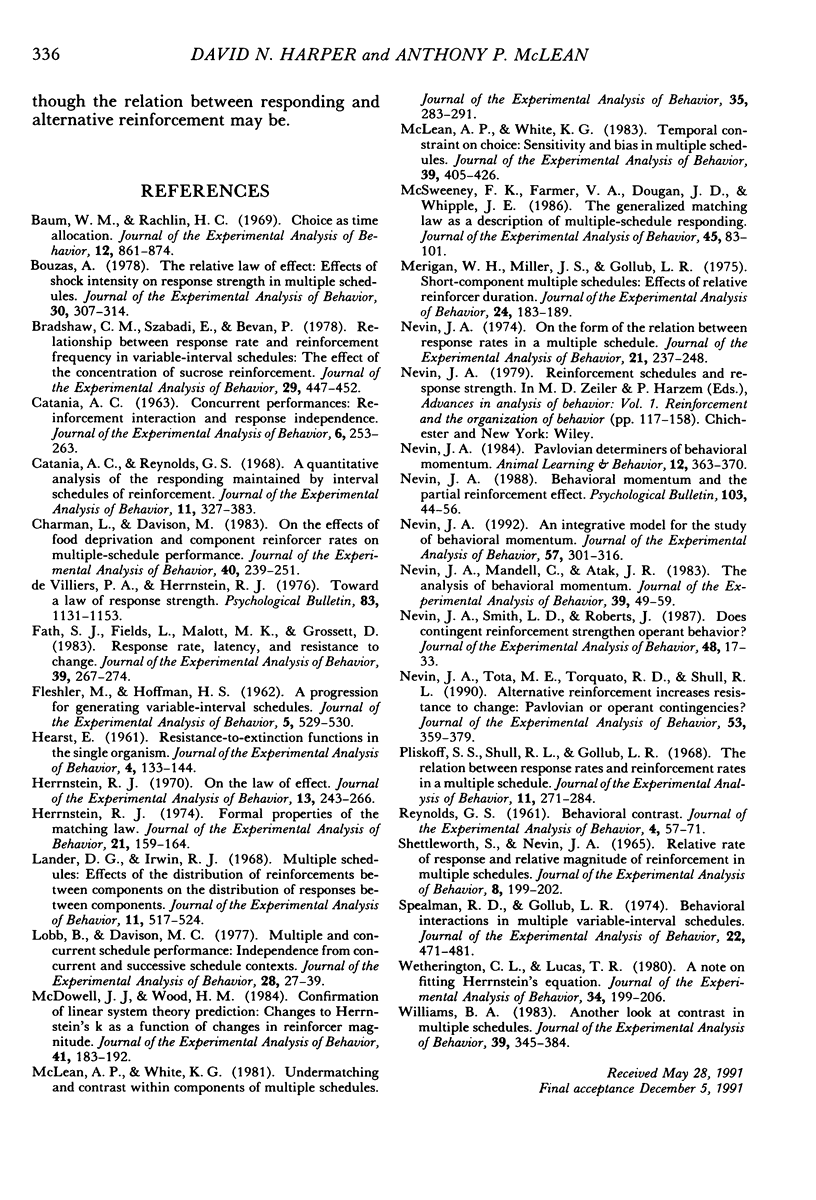
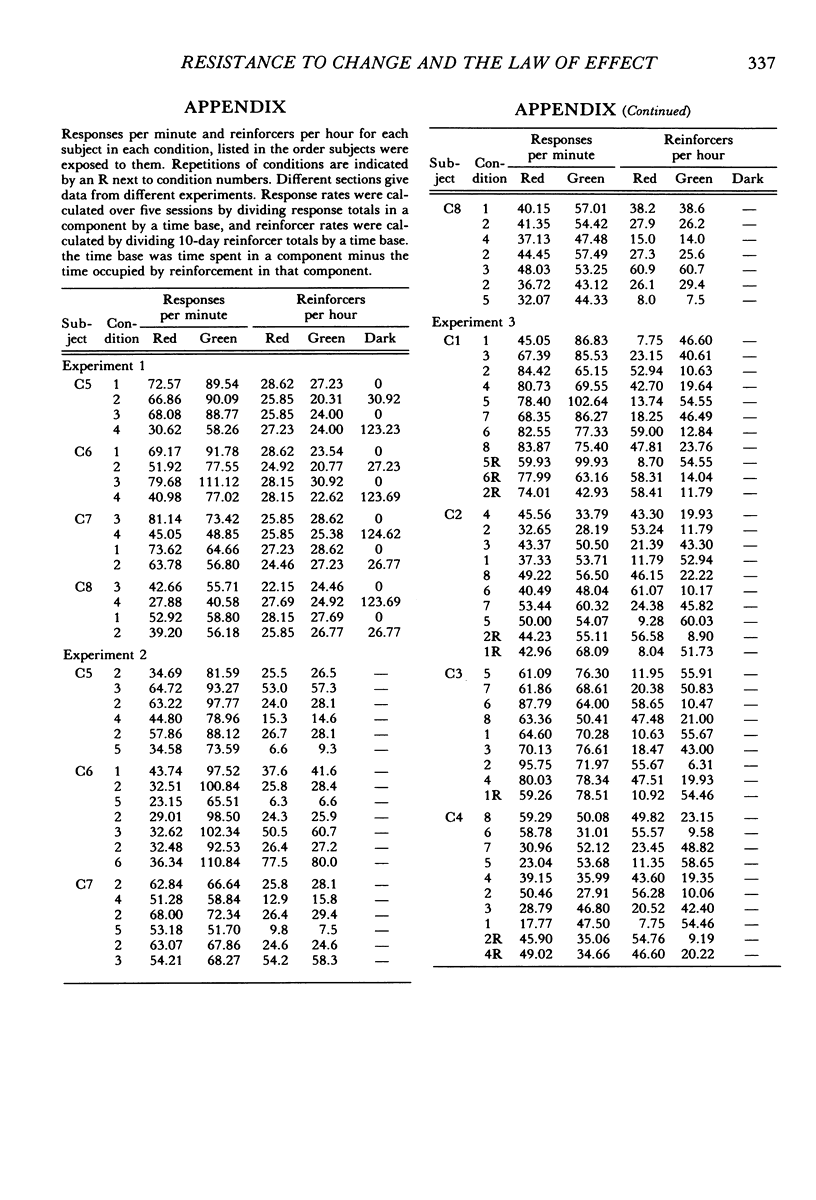
Selected References
These references are in PubMed. This may not be the complete list of references from this article.
- Baum W. M., Rachlin H. C. Choice as time allocation. J Exp Anal Behav. 1969 Nov;12(6):861–874. doi: 10.1901/jeab.1969.12-861. [DOI] [PMC free article] [PubMed] [Google Scholar]
- Bouzas A. The relative law of effect: effects of shock intensity on response strength in multiple schedules. J Exp Anal Behav. 1978 Nov;30(3):307–314. doi: 10.1901/jeab.1978.30-307. [DOI] [PMC free article] [PubMed] [Google Scholar]
- Bradshaw C. M., Szabadi E., Bevan P. Relationship between response rate and reinforcement frequency in variable-interval schedules: the effect of the concentration of sucrose reinforcement. J Exp Anal Behav. 1978 May;29(3):447–452. doi: 10.1901/jeab.1978.29-447. [DOI] [PMC free article] [PubMed] [Google Scholar]
- CATANIA A. C. Concurrent performances: reinforcement interaction and response independence. J Exp Anal Behav. 1963 Apr;6:253–263. doi: 10.1901/jeab.1963.6-253. [DOI] [PMC free article] [PubMed] [Google Scholar]
- Catania A. C., Reynolds G. S. A quantitative analysis of the responding maintained by interval schedules of reinforcement. J Exp Anal Behav. 1968 May;11(3 Suppl):327–383. doi: 10.1901/jeab.1968.11-s327. [DOI] [PMC free article] [PubMed] [Google Scholar]
- Charman L., Davison M. On the effects of food deprivation and component reinforcer rates on multiple-schedule performance. J Exp Anal Behav. 1983 Nov;40(3):239–251. doi: 10.1901/jeab.1983.40-239. [DOI] [PMC free article] [PubMed] [Google Scholar]
- FLESHLER M., HOFFMAN H. S. A progression for generating variable-interval schedules. J Exp Anal Behav. 1962 Oct;5:529–530. doi: 10.1901/jeab.1962.5-529. [DOI] [PMC free article] [PubMed] [Google Scholar]
- Fath S. J., Fields L., Malott M. K., Grossett D. Response rate, latency, and resistance to change. J Exp Anal Behav. 1983 Mar;39(2):267–274. doi: 10.1901/jeab.1983.39-267. [DOI] [PMC free article] [PubMed] [Google Scholar]
- HEARST E. Resistance-to-extinction functions in the single organism. J Exp Anal Behav. 1961 Apr;4:133–144. doi: 10.1901/jeab.1961.4-133. [DOI] [PMC free article] [PubMed] [Google Scholar]
- Herrnstein R. J. Formal properties of the matching law. J Exp Anal Behav. 1974 Jan;21(1):159–164. doi: 10.1901/jeab.1974.21-159. [DOI] [PMC free article] [PubMed] [Google Scholar]
- Herrnstein R. J. On the law of effect. J Exp Anal Behav. 1970 Mar;13(2):243–266. doi: 10.1901/jeab.1970.13-243. [DOI] [PMC free article] [PubMed] [Google Scholar]
- Lander D. G., Irwin R. J. Multiple schedules: effects of the distribution of reinforcements between component on the distribution of responses between conponents. J Exp Anal Behav. 1968 Sep;11(5):517–524. doi: 10.1901/jeab.1968.11-517. [DOI] [PMC free article] [PubMed] [Google Scholar]
- Lee Wetherington C., Lucas T. R. A note on fitting Herrnstein's equation. J Exp Anal Behav. 1980 Sep;34(2):199–206. doi: 10.1901/jeab.1980.34-199. [DOI] [PMC free article] [PubMed] [Google Scholar]
- Lobb B., Davison M. C. Multiple and concurrent schedule performance: independence from concurrent and successive schedule contexts. J Exp Anal Behav. 1977 Jul;28(1):27–39. doi: 10.1901/jeab.1977.28-27. [DOI] [PMC free article] [PubMed] [Google Scholar]
- McDowell J. J., Wood H. M. Confirmation of linear system theory prediction: Changes in Herrnstein's k as a function of changes in reinforcer magnitude. J Exp Anal Behav. 1984 Mar;41(2):183–192. doi: 10.1901/jeab.1984.41-183. [DOI] [PMC free article] [PubMed] [Google Scholar]
- McLean A. P., White K. G. Temporal constraint on choice: Sensitivity and bias in multiple schedules. J Exp Anal Behav. 1983 May;39(3):405–426. doi: 10.1901/jeab.1983.39-405. [DOI] [PMC free article] [PubMed] [Google Scholar]
- McLean A. P., White K. G. Undermatching and contrast within components of multiple schedules. J Exp Anal Behav. 1981 May;35(3):283–291. doi: 10.1901/jeab.1981.35-283. [DOI] [PMC free article] [PubMed] [Google Scholar]
- McSweeney F. K., Farmer V. A., Dougan J. D., Whipple J. E. The generalized matching law as a description of multiple-schedule responding. J Exp Anal Behav. 1986 Jan;45(1):83–101. doi: 10.1901/jeab.1986.45-83. [DOI] [PMC free article] [PubMed] [Google Scholar]
- Merigan W. H., Miller J. S., Gollub L. R. Short-component multiple schedules: effects of relative reinforcement duration. J Exp Anal Behav. 1975 Sep;24(2):183–189. doi: 10.1901/jeab.1975.24-183. [DOI] [PMC free article] [PubMed] [Google Scholar]
- Nevin J. A. An integrative model for the study of behavioral momentum. J Exp Anal Behav. 1992 May;57(3):301–316. doi: 10.1901/jeab.1992.57-301. [DOI] [PMC free article] [PubMed] [Google Scholar]
- Nevin J. A., Mandell C., Atak J. R. The analysis of behavioral momentum. J Exp Anal Behav. 1983 Jan;39(1):49–59. doi: 10.1901/jeab.1983.39-49. [DOI] [PMC free article] [PubMed] [Google Scholar]
- Nevin J. A. On the form of the relation between response rates in a multiple schedule. J Exp Anal Behav. 1974 Mar;21(2):237–248. doi: 10.1901/jeab.1974.21-237. [DOI] [PMC free article] [PubMed] [Google Scholar]
- Nevin J. A., Smith L. D., Roberts J. Does contingent reinforcement strengthen operant behavior? J Exp Anal Behav. 1987 Jul;48(1):17–33. doi: 10.1901/jeab.1987.48-17. [DOI] [PMC free article] [PubMed] [Google Scholar]
- Nevin J. A., Tota M. E., Torquato R. D., Shull R. L. Alternative reinforcement increases resistance to change: Pavlovian or operant contingencies? J Exp Anal Behav. 1990 May;53(3):359–379. doi: 10.1901/jeab.1990.53-359. [DOI] [PMC free article] [PubMed] [Google Scholar]
- Pliskoff S. S., Shull R. L., Gollub L. R. The relation between response rates and reinforcement rates in a multiple schedule. J Exp Anal Behav. 1968 May;11(3):271–284. doi: 10.1901/jeab.1968.11-271. [DOI] [PMC free article] [PubMed] [Google Scholar]
- REYNOLDS G. S. Behavioral contrast. J Exp Anal Behav. 1961 Jan;4:57–71. doi: 10.1901/jeab.1961.4-57. [DOI] [PMC free article] [PubMed] [Google Scholar]
- SHETTLEWORTH S., NEVIN J. A. RELATIVE RATE OF RESPONSE AND RELATIVE MAGNITUDE OF REINFORCEMENT IN MULTIPLE SCHEDULES. J Exp Anal Behav. 1965 Jul;8:199–202. doi: 10.1901/jeab.1965.8-199. [DOI] [PMC free article] [PubMed] [Google Scholar]
- Spealman R. D., Gollub L. R. Behavioral interactions in multiple variable-interval schedules. J Exp Anal Behav. 1974 Nov;22(3):471–481. doi: 10.1901/jeab.1974.22-471. [DOI] [PMC free article] [PubMed] [Google Scholar]
- Williams B. A. Another look at contrast in multiple schedules. J Exp Anal Behav. 1983 Mar;39(2):345–384. doi: 10.1901/jeab.1983.39-345. [DOI] [PMC free article] [PubMed] [Google Scholar]


